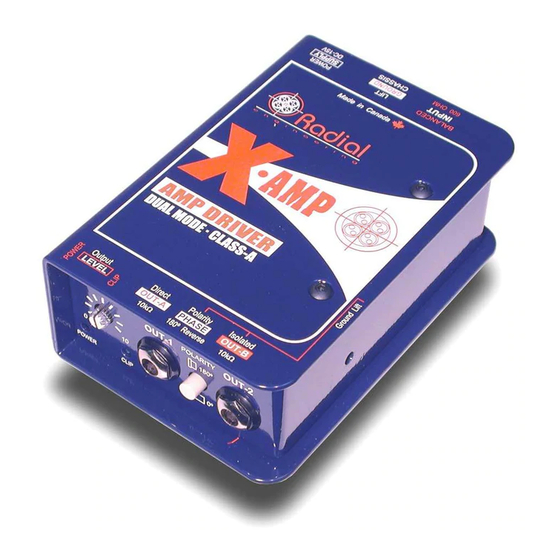Summary of Contents for Radial Engineering X-AMP
-
Page 1: User Guide
Radial Amp Driver •AMP User Guide Radial Engineering 1638 Kebet Way, Port Coquitlam BC V3C 5W9 tel: 604-942-1001 fax: 604-942-1010 email: info@radialeng.com Radial Engineering is a division of C•TEC (JP CableTek Electronics Ltd.) -
Page 2: Table Of Contents
To this end, we recommend reading this manual before operating your X-Amp. We are confident you will find the Radial X-amp to be fun to use, musical and that it will open new doors to creativity. -
Page 3: Caution Statement, Please Read Before Using
120V present between the amp chassis and ground. Radial Engineering takes no responsibility for this or how the X-AMP is connected or used. It is the user’s full responsibility to ensure that proper electrical polarity is maintained on all equipment connected to the X-AMP and that proper building electrical codes have been followed wherever the X-AMP is being used. -
Page 4: Introduction - What Is The X-Amp
True to the Music INTRODUCTION Designed as a creative tool, the Radial X-Amp is an active re- amplifying device that allows prerecorded instrument tracks to be sent through guitar amplifiers and effect devices. Although the Radial X-amp is new, the process of re-amping tracks has been around for years. - Page 5 X-Amp features two ground lift switches to allow optimal ground conditions in complex environments. And like all Radial products, the X-Amp is built to handle abuse with 14-gauge welded steel inner frame, baked enamel finish and our innovative bookend design that creates a protective zone around the switches, potentiometer and connectors.
-
Page 6: Input Panel
INPUT PANEL FEATURE SET 1. Balanced line level input connector The input to the Radial X-Amp is a balanced 600-ohm line level. This is typically driven from the line level output from a recording device or from a console. The XLR female connector is wired with Pin 2 hot following the AES standard. -
Page 7: Output Panel
8. Input overload LED indicator To ensure the signal from the mixer or recorder does not overload the X-Amp, a clip indicator is positioned on the front panel for clear viewing. If this LED illuminates, turn down the mixer! 9. Out-1: Direct ¼” output to guitar amp 1... -
Page 8: Using The X-Amp
True to the Music USING THE X-AMP Step 1 – Record a dry track As most re-amping is performed with an electric guitar, we have chosen to discuss the process using this as an example. The same process applies with voice, keyboard, violin and any other instrument. - Page 9 Power LED on the front control panel should illuminate. Play the track and turn up the recorders/mixers output until the Clip light on the X-Amp blinks occasionaly with peaks in the recording. Now turn the output back so the clip light does not blink at all.
- Page 10 Using the X-Amp with voice Often times, voices can be too clean and lack that ‘seasoned’ rough edge. By driving a voice track through the X-Amp into a distortion pedal like the Radial Tonebone Classic or through an overdriven amplifier, one can introduce some great effects.
-
Page 11: Grounding Options
Why do you have to use Out-1 when using the X-Amp? Out-1 is the primary ground path for the X-Amp and needs to be connected to a properly grounded amplifier so that the chassis can work as a screen against RF and other magnetically induced noise hazards. -
Page 12: Specifications
True to the Music Can I drive effect pedals with the X-Amp? Absolutely! The X-Amp is perfect for this type of thing! Connect the same way as with an amplifier as described in the manual. Have fun and experiment! Will my guitar effects sound the same if I bring them... -
Page 13: History Of Re-Amping
Wall of sound pioneer Phil Spector is perhaps the most widely accredited for the use of the reamping process and because of his association with the Beatles is potentially regarded today as the developer of the process. However, Phil was Radial Engineering X•AMP User Guide... - Page 14 This same application is mentioned in the Radial JDI direct box owner’s manual and referred to as ‘using the JDI backwards’. Radial Engineering X•AMP User Guide...
- Page 15 In 2004, Radial introduced the Radial X-Amp which is an active device that allows a pre-recorded balanced signal to drive two guitar type amplifiers at the same time.
- Page 16 LEGAL RIGHTS, AND YOU MAY ALSO HAVE OTHER RIGHTS, WHICH MAY VARY, FROM STATE TO STATE (OR PROVINCE TO PROVINCE). True to the Music 1638 Kebet Way, Port Coquitlam BC V3C 5W9 tel: 604-942-1001 fax: 604-942-1010 email: info@radialeng.com www.radialeng.com Radial X-Amp manual V1.0 - Part #: R800-9646-00...

















Need help?
Do you have a question about the X-AMP and is the answer not in the manual?
Questions and answers